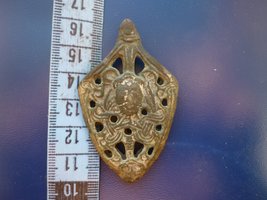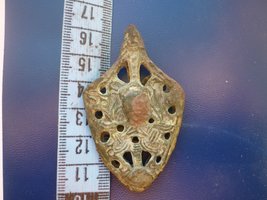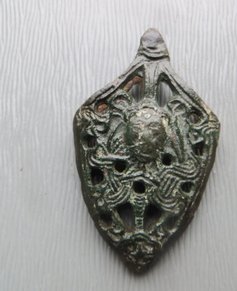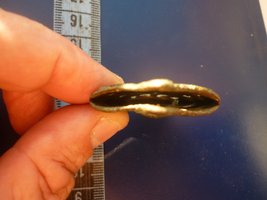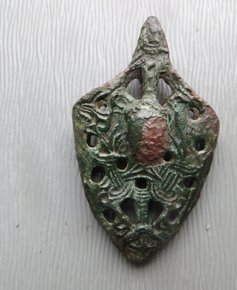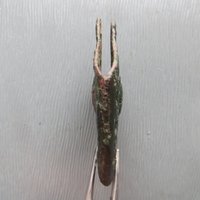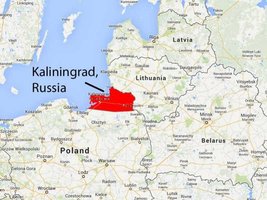Odin's self sacrifice as a protection for the Viking sword ?
As said some weeks ago I would return to a specific kind of sword chape.
My friend Ru Smith had aquired a similar viking sword chape last Autumn, and I think altogether our views on this sword chape, (Paulsen (1953) type B, 10th C) deserves an combined article.
As said before, Charlotte Hedenstierna-Johnson pointed out in her article, A group of Viking Age sword chapes reflecting the political geography of the time to a possible religious aspect of the image, the crucifixion.
Ru Smith is questioning that matter in his article about his example of this sword chape A Viking Sword Chape and the Hávamál Story of Odin's Self-sacrifice. Examining my sword chape with the magnifier, I did somewhat of an not too much expected discovery. As in Viking Antiques markets and auctions a lot of storytelling and 'Odinning' and depicting like Norse god This and That is going on, I was and am always cautious just believing what the seller is saying or believing himselve..
Especially when elves are being involved ;)
Then again, how could we be for sure 100%, as we have no connection with the Vikings afterlife ?
Back to the magnifier.. I noticed that one eye (left eye - that is the one on the right for you, watching the chape on the image ;) is clearly to be seen as an eye on the metal .. the other eye .. just isn't visible, not because it had abraised on the metal in some kind of way, no, because it seems to deliberately had been omitted.
On the place where you would suspect the other eye, a slightly hollow eye is visible as a well casted dent ...
So... Odin after all ?
As said before: we cannot 'prove' images too quickly, it is very well possible that Ru Smith's thoughts on the self sacrifice of Odin could make sence.
Then, let us just move ourselves in the heads and belief of our pagan ancestors.
Why nót depict Odin on a sword chape, to protect the carrier of the sword by giving him the wisdom of Odin in battle and remembering the sacrifice one needs in life to achieve its goals ?
My example was found about two years ago near the little town of Kreutburg, twenty miles south of Kaliningrad in that funny Russian-owned Kaliningrad Oblast area east of Poland.
The images of the chape above shows the chape in 'just cleaned' situation.
The images of the chape beneath shows the chape, then coated with Paraloid B-72. The seller had used it with the purpose to conservate the piece. I will check on the Archaeological Services in Holland, if this was a good thing to do..
For further references to this stunning piece of Viking Art I point out to the ones given in Ru Smit's blog above..
The map shows the area the sword chape was found (south of Kaliningrad).
I have shared our thoughts with Charlotte Hedenstierna-Johnson who responded: Odin is Always a bit elusive, even as archaeological finds go...'.
And that, my Viking Age interestees and students and researchers, is the attractiviness of our part of field of research..
We do not, and cannot know everything for sure. That is the mystery, the everduring desire to investigate and deliberate ..
Thomas Kamphuis, May 22th 2015.
See for the general - very interesting - website of Ru Smith : http://www.pbase.com/hajar/viking_art
and the specific page on his sword chape : http://www.pbase.com/hajar/image/158520131
With thanks to Ru Smith
Well. I could have been with these stones until after dark, but as my wife wanted to travel on.. well.. I see you again, some day, hogback stones from Gosforth. And if you happen to be there one day, do not forget that monument on the outside...
Further on with the Cumbrian hogbacktour !
In - yes, luckily again in - St. Peter's church in Heysham, there is a truly beautiful hogback stone. The guide told us, it had been studyied by Thor Ewing, a writer, in 2000. in 'Understanding the Heysham hogback' A tenth century sculpted stone monument and its context (link), Thor Ewing tells in detail what he dicovered on the both sides of this hogback stone.
Just being brought in the church as late as the 1970's accompanied with some protest here and there among the church visitors, considered as being a token of old paganism, it had been remarkably nice preserved, and a lot of detail can be seen, still. Truly worthwile a visit.
I had a small debate with the guide in the church if the - zoomorphic, in my opinion - faces on the sides were lions (or hippo's). The guide doubted if the vikings could have known about lions. Well I guess so, concerning the runes on the Ancient Greek lion statue at the Arsenal, Venice. For example. Vikings did travel south..
But when he told me he was doubting the vikings 'discovered' (as the native inhabitants were of course, in the first place) America before Columbus, I decided to rest my case..
One has to know when to start and to end a conversation ..
Just discovered the book in a bookstore written by Geoff Holder - The guide to the mysterious Lake District, I knew there had to be another hogback stone in Lowther, St. Micheal's Church. With a promising image described in the text of 'a naval and a land-based force of shield-bearing vikings above a fish and what might be a coiled sea serpent. On the reverse is a row of female figures with snakes, possibly a representation of the hideous hag Hel'. Wow. If that did not sound as a true pagan promised land ..
Not complaing too much after all we have seen, this visit was the dissapointing one of them all. But if you wife states 'I am happy to have seen them' and I am answering 'Measuring is knowing' and the even more obligate verb 'handling 'if we did not see it at all, we wouldn't have known anything at all of how they were looking' the glass was again half full, at the last day of our journey..
The hogback stone appeared to be just being tolerated within the entrance segment part of the church. As something you never use anymore but you do not throw away - entirely. That sort of feeling emerged when seeing this hogback asylum seekers.. Bed, bath and bread, ás we say in Dutch, but no luxury at all and standing on some outcuts of wood, you would balance the table with at home..
Come on, St. Micheal's Church.. care a bit more of your 'children' !
This hogback stone was moved in the church in 1907. Hogback stones layed partially buried in the churchyard before it was dug up and moved into the church.
The promising depiction of a longship - as certainly can be seen after some studying - see http://vikingminds.co.uk/pages/longship
we have missed !
The stone itself is (157 x 50 x 30 cm) and very worn.
The hogback stones in Cumbria - very diverse in quality, but everyone worth a visit ! Especially on a gloomy day in late October ...
The churches to visit - see photos of resp. St. Andrew's church in Penrith, St. Mary's church in Gosforth, St. Peter's church in Heysham and St. Micheal's church in Lowther.
Did I miss out on another one in Cumbria ? Let me know !
In a next blog I will take you to four - still remaining utterly mysterious- statues 'guarding' the graveyard of St. Andrew's church in Dacre..
For the last blog of October 9th see this link.
References: (as always, links to where the books can be ordered are attached).
Edwards, B.J.N. Vikings in North West England - The artifacts (1998);
Emery, Gordon, CURIOUS CUMBRIA, The Lake District & Beyond: A celebration of Cumbria (2023)
Ewing, T. 'Understanding the Heysham hogback' A tenth century sculpted stone monument and its context ;
Hall, R. Viking Age archaeology in Britain and Ireland (first printed 1990, reprinted with amendments in 1995);
Holder, G. The guide to the mysterious Lake District (2009)
possibly also (as there within the part of Cumbria dealing with Carlisle, the Eden Valley, Barrow-in-Furness, Whitehaven and the west coast is being dealed with)
Holder, G. Paranormal Cumbria (2010)
http://vikingminds.co.uk/pages/longship
